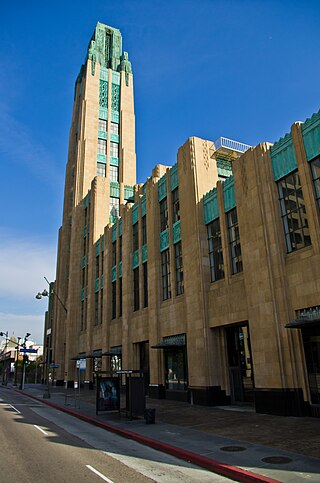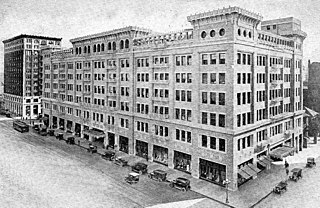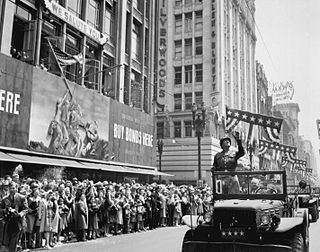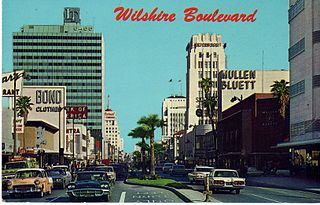Related Research Articles

Miracle Mile is a neighborhood in the city of Los Angeles, California.
Ohrbach's was a moderate-priced department store with a merchandising focus primarily on clothing and accessories. From its modest start in 1923 until the chain's demise in 1987, Ohrbach's expanded dramatically after World War II, and opened numerous branch locations in the New York and Los Angeles metropolitan areas. Its original flagship store was located on Union Square in New York City. It maintained administrative offices in Newark and in Los Angeles. The retailer closed the Newark offices in the 1970s. Paul László designed the Union Square store as well as many of their other stores.

Wilshire Boulevard ('wɪɫ.ʃɚ) is a prominent 15.83 mi (25.48 km) boulevard in the Los Angeles area of Southern California, extending from Ocean Avenue in the city of Santa Monica east to Grand Avenue in the Financial District of downtown Los Angeles. One of the principal east-west arterial roads of Los Angeles, it is also one of the major city streets through the city of Beverly Hills. Wilshire Boulevard runs roughly parallel with Santa Monica Boulevard from Santa Monica to the west boundary of Beverly Hills. From the east boundary it runs a block south of Sixth Street to its terminus.

Bullocks Wilshire, located at 3050 Wilshire Boulevard in Los Angeles, California, is a 230,000-square-foot (21,000 m2) Art Deco building. The building opened in September 1929 as a luxury department store for owner John G. Bullock. Bullocks Wilshire was also the name of the department store chain of which the Los Angeles store was the flagship; it had seven stores total; Macy's incorporated them into and rebranded them as I. Magnin in 1989, before closing I. Magnin entirely in 1994. The building is currently owned by Southwestern Law School.

Stiles Oliver Clements was an architect practicing in Los Angeles and Southern California.

J. W. Robinson Co., Robinson's, was a chain of department stores operating in the Southern California and Arizona area, previously with headquarters in Los Angeles, California.

Bullock's was a chain of full-line department stores from 1907 through 1995, headquartered in Los Angeles, growing to operate across California, Arizona and Nevada. Bullock's also operated as many as seven more upscale Bullocks Wilshire specialty department stores across Southern California. Many former Bullock's locations continue to operate as Macy's.
I. Magnin & Company was a San Francisco, California-based high fashion and specialty goods luxury department store. Over the course of its existence, it expanded across the West into Southern California and the adjoining states of Arizona, Oregon, and Washington. In the 1970s, under Federated Department Stores ownership, the chain entered the Chicago, Illinois, and Washington, DC, metropolitan areas. Mary Ann Magnin founded the company in 1876 and named the chain after her husband Isaac.

May Company California was a chain of department stores operating in Southern California and Nevada, with headquarters in North Hollywood, California. It was a subsidiary of May Department Stores and merged with May's other Southern California subsidiary, J. W. Robinson's, in 1993 to form Robinsons-May.
Bond Clothing Stores, Bond Clothes, Bond Clothiers, or Bond Stores, was a men's clothing manufacturing company and retailer. The company catered to the middle-class consumer.
Akron Stores or The Akron was a Southern California-based imported goods and home decorating department store retail chain established in 1947 and was known to carry unusual merchandise, mostly imports. The chain had over 24 stores throughout Southern California from San Diego to San Francisco before it was forced to close in 1985.
Los Altos Center is a regional shopping mall in the Los Altos area of northeastern Long Beach, California along Bellflower Boulevard, 4 miles south of Lakewood Center Mall and 5 miles east of Downtown Long Beach.

Coulter's was a department store that originated in Downtown Los Angeles and later moved to the Miracle Mile shopping district in that same city.

Mullen & Bluett was a Los Angeles-based department store specializing in men's clothing.

Phelps-Terkel was a Los Angeles based department store specializing in men's clothing. Its Miracle Mile, Los Angeles Modernist store at 5550 Wilshire Boulevard, corner of S. Burnside Avenue, was considered a landmark by the Los Angeles Conservancy's Modern Committee.

Myer Siegel was a Los Angeles-based department store, founded by Myer Siegel (1866–1934), specializing in women's clothing.

The Famous Department Store was a department store in Los Angeles, California.

7th Street is a street in Los Angeles, California running from S. Norton Ave in Mid-Wilshire through Downtown Los Angeles. It goes all the way to the eastern city limits at Indiana Ave., and the border between Boyle Heights, Los Angeles and East Los Angeles.
Adray's was the name of two appliance and electronics retailers, one a single store and the other a chain of stores, both based in Southern California. The independent store at 1809 W. Chapman Avenue in the City of Orange had been fully owned by Lou Adray since 1971 when he bought out its founders, his brother Andy and their cousin Eddie Aladray. This store was described by the Los Angeles Times at its closure in 1998 as an "institution". The separate store chain, also branded Adray's but incorporated as Adry-Mart Inc., was run by Lou Adray's relatives and operated up to 10 stores in Los Angeles and Ventura Counties.

Retail in Southern California dates back to its first dry goods store that Jonathan Temple opened in 1827 on Calle Principal, when Los Angeles was still a Mexican village. After the American conquest, as the pueblo grew into a small town surpassing 4,000 population in 1860, dry goods stores continued to open, including the forerunners of what would be local chains. Larger retailers moved progressively further south to the 1880s-1890s Central Business District, which was later razed to become the Civic Center. Starting in the mid-1890s, major stores moved ever southward, first onto Broadway around 3rd, then starting in 1905 to Broadway between 4th and 9th, then starting in 1915 westward onto West Seventh Street up to Figueroa. For half a century Broadway and Seventh streets together formed one of America's largest and busiest downtown shopping districts.
References
- 1 2 "17 Sep 1926, Page 11 - Santa Ana Register at Newspapers.com". Newspapers.com.
- ↑ "Mandel's "Fascinating Slippers" store :: Los Angeles Public Library Photo Collection". tessa.lapl.org.
- ↑ "14 May 1967, 130 - The Los Angeles Times at Newspapers.com". Newspapers.com.
- ↑ "Men's Wear". Fairchild Publications. 1 May 1973 – via Google Books.
- ↑ "14 Mar 1936, 5 - The Los Angeles Times at Newspapers.com". Newspapers.com.
- ↑ "Clipping from The Los Angeles Times". Newspapers.com.
- ↑ "28 Aug 1957, 40 - The Los Angeles Times at Newspapers.com". Newspapers.com.
- ↑ Wallach, Ruth (9 July 2013). "Miracle Mile in Los Angeles: History and Architecture". Arcadia Publishing – via Google Books.
- ↑ "Mandel's Glendale Open House 327 N. Brand Blvd". Newspapers.com.
- ↑ "16 May 1965, Page 59 - Independent Press-Telegram at Newspapers.com". Newspapers.com.
- ↑ "29 Jul 1962, Page 73 - Independent Press-Telegram at Newspapers.com". Newspapers.com.
- ↑ "6 Jul 1949, Page 6 - Long Beach Independent at Newspapers.com". Newspapers.com.
- ↑ "10 Nov 1957, 121 - The Los Angeles Times at Newspapers.com". Newspapers.com.
- ↑ "23 Oct 1927, 11 - El Paso Times at Newspapers.com". Newspapers.com.
- ↑ "25 May 1927, Page 2 - Arizona Republic at Newspapers.com". Newspapers.com.
- ↑ Company, Johnson Publishing (16 January 1958). "Jet". Johnson Publishing Company – via Google Books.
- ↑ "Lambert v. Mandel's of California". Justia Law.